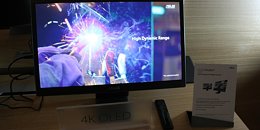Raevenlord
News Editor
- Joined
- Aug 12, 2016
- Messages
- 3,755 (1.20/day)
- Location
- Portugal
| System Name | The Ryzening |
|---|---|
| Processor | AMD Ryzen 9 5900X |
| Motherboard | MSI X570 MAG TOMAHAWK |
| Cooling | Lian Li Galahad 360mm AIO |
| Memory | 32 GB G.Skill Trident Z F4-3733 (4x 8 GB) |
| Video Card(s) | Gigabyte RTX 3070 Ti |
| Storage | Boot: Transcend MTE220S 2TB, Kintson A2000 1TB, Seagate Firewolf Pro 14 TB |
| Display(s) | Acer Nitro VG270UP (1440p 144 Hz IPS) |
| Case | Lian Li O11DX Dynamic White |
| Audio Device(s) | iFi Audio Zen DAC |
| Power Supply | Seasonic Focus+ 750 W |
| Mouse | Cooler Master Masterkeys Lite L |
| Keyboard | Cooler Master Masterkeys Lite L |
| Software | Windows 10 x64 |
JOLED, a Japanese Display, Sony and Panasonic group, has announced new OLED solutions for PC monitors that are expected to enter the market in 2019. While OLED has become ubiquitous in both high-end smartphones and TV's, some of the technology's quirks (read: burn-in) mean that it has some more problems that need addressing compared to the other, more traditional display panel technologies. That's likely one of the reasons OLEDs are taking so long to enter the PC monitor market, even though some of their characteristics (such as the fact that the announced JOLED models can features repsosne times of 0.1 ms) are naturally gamer-appealing.
The market entries will start small, with 21.6" diagonals in both 1080p (geared for gamers in partnership with Japanese e-sports team Burning Core) and 4K (which should make its way to the market inside ASUS' Proart PQ22UC. For some reason, there's apparently a 27" panel that's being developed specifically for smart home applications, instead of for the gaming crowds. Go figure.

View at TechPowerUp Main Site
The market entries will start small, with 21.6" diagonals in both 1080p (geared for gamers in partnership with Japanese e-sports team Burning Core) and 4K (which should make its way to the market inside ASUS' Proart PQ22UC. For some reason, there's apparently a 27" panel that's being developed specifically for smart home applications, instead of for the gaming crowds. Go figure.

View at TechPowerUp Main Site






